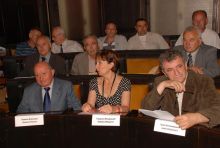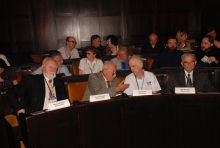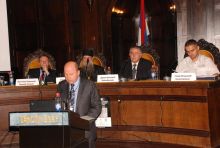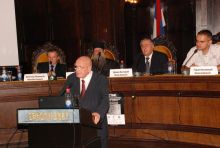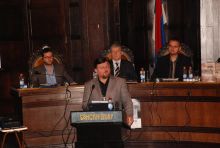In organisation of the Association of Descendants and Supporters of the Victims of the Complex of Ustasha Camps Gospić-Jadovno 1941, and in co-organisation of the Institute for Contemporary History from Belgrade and the Academy of Arts and Sciences of Republika Srpska, the First International Conference on the Complex of Ustasha Camps Gospić-Jadovno 1941 was held on 24 and 25 June, 2011 at the Conference Hall of the Banski Dvor in Banja Luka. Around fifty participants from Serbia, Croatia, Israel, United States of America, Italy, Germany, Russia, Austria, Republika Srpska and other countries took part in the Conference.
The Conference was opened by the President of the Conference Organizing Committee, Dr Dušan Bastašić, which was followed by welcoming addresses by representatives of co-organizers, Professor Dr Rajko Kuzmanivć, the President of the Academy of Arts and Sciences of Republika Srpska and Professor Dr Momčilo Pavlović, the Director of the Institute for Contemporary History from Belgrade. Elected Episcope of Lipljan Archimandrite Jovan Ćulibrk greeted the participants of the Conference on behalf the Holy Archpriest Synod of the Serbian Orthodox Church. Father Jovan also informed the attendees that the management of Yad Vashem decided to classify this Conference as an international scientific Holocaust event of the first- grade importance.
The Conference was also greeted by an envoy of the President of the Republic of Serbia, Mr Mlađan Đorđević, as well as an envoy of the President of the Republika Srpska, Senator Arie Livne.
The introductory presentation was given by Dr Đuro Zatezalo, a historian who spent a large part of his working years studying tragedies of the Gospić system of Ustasha camps, which resulted in two capital books on the topic. The participants of the conference gave him special recognition for his efforts in researching and describing the tragedy in Jadovno and on Pag at the beginning of the Second World War in this area. The Conference commended and praised all Dr Zatezalo’s efforts in preserving the memory of the victims of the Ustasha system of camps Gospić, the first death camp in the criminal Independent State of Croatia, which existed from 11 April to 21 August 1941.
The series of systematic mass murders of innocent people in the wartime Croatia did not stop and lasted until 22 April, 1945 and the breakthrough of the last inmates of Jasenovac, because the last inmates from Pag and Jadovno were at the same time the first inmates of Jasenovac. According to long years of research by Dr Zatezalo, during the operation of the Gospić system of death camps the total of 40,123 persons were murdered (38,010 Serbs, 1998 Jews, 88 Croats, 11 Slovenians, nine Muslims, two Hungarians, two Checks, one Russian, one Roma and one Montenegrin), in so far recorded 33 bottomless pits on Velebit, Šaranova Pit near Jadovno being the one which devoured most of the victims, and the Gospić camp itself (prison, collection point at the railway station), camp Ovčara near Gospić, then the camp near Risova Glava, camp Slana and camp Metajna, and camp Stupačinovo near Baške Oštarije.
The Conference did not stop just on direct tragedy in Jadovno and on Pag, but this topic became a starting point for various expert presentations based on memories and study of Genocide, Holocaust, but also historical revisionism, which has been plaguing Eastern Europe, from the Baltic to the Black Sea, with the Balkans as no exception, especially Croatia.
After the introductory presentation by Dr Đuro Zatezalo, a Conference session followed named „Memory is not enough“ chaired by elected Episcope of Lipljan and Patriarch’s Vicar, Bishop Jovan (Ćulibrk).
In the first session the presentations were held by: President of the Union of Jewish Municipalities of Serbia Aleksandar Nećak (paper “Memory is not enough”); former President of the Union of Jewish Municipalities of BH and Expert Associate at the Hebrew University in Jerusalem Ivan Čerešnješ (paper “Memory as ideology in changing societies – ‘Never again’ as a paradigm to the memory of Holocaust”); lecturer from the University of Vienna and expert in political science Dr Ljiljana Radonić (paper: „War of memories in the post-Yugoslav area“), and university lecturer at the Political Sciences Department of the Ball University in the United States Dr Francine Friedman read a letter to the Conference by the Executive Director of the Simon Wiesenthnal Centre in Jerusalem Dr Efraim Zuroff (who was supposed to present the paper “Importance of post-Holocaust justice in Eastern Europe after the fall of communism”), after which Mr Salamon Jazbec from the Margel Institute in Zagreb spoke about the Ašner case and important social messages sent by the failure to prosecute him in Croatia and Austria.
Mr Jazbec spoke about the need to punish war crimes from the time of Holocaust, and the time of genocide over Serbian people in the criminal Independent State of Croatia. His speech coincided with the announcement of the death of Ustasha war criminal Milivoj Ašner, who died at the age of 99 without being punished in Celovec, his place of residence after he had escaped Croatian authorities in early June 2004. The full auditorium was very interested in this speech. As a manager of the town police department in Požega during the war, Milivoj Ašner is responsible for deportations of innocent citizens of Požega to the system of Ustasha camps Gospić-Jadovno, based on criminal racial legislation and genocide policy of the Ustasha NDH.
Aleksandar Nećak’s paper gave some lessons we should take from everything that was and was not done in the past few decades in preserving the memory of Holocaust in Serbia and in the Balkans, with the resume – the memory is not enough. With memory and memorials, we should not neglect research and education, especially in the light of the fact that it has been 66 years since the end of the Second World War; therefore young generations are not aware enough of all events in the area from 1941 to 1945. “When a society does not educate young people, it creates a possibility and leaves room for intolerance, xenophobia, racism, hatred and anti-Semitism”, as he said in his paper. Along with that, in his paper Dr Zuroff adds that it is necessary to bring Holocaust criminals to justice, to make people aware of collaborations, to accept the guilt, but also to have restitution.
With a rich and very impressive video presentation, Čerešnješ tried to explain how to “bridge history and collective memory of Jews and non-Jewish communities that exist in the same areas”. He showed that with examples of (non-)preserved Jewish graveyards and monuments from the People’s Liberation Struggle in Yugoslavia, i.e. memorials of the suffering of the Jews in the Second World War in the Balkans, as well as genocide over Serbs and other peoples.
A valuable presentation by Dr Radonić provoked reactions and a fruitful discussion, rebuttals and explanations, which is very useful and adds an interesting dimension to such conferences; the character of the Conference without some controversy would not be complete, and its shape would not be distinguished. The basic thesis of Liljana Radonić’s paper was that “individuals and collectives use the memory of the past for purposes of the present, remembering only those events which they can fit into their own image of themselves or their group”, with the final question: whether, in ‘the war of memories’ we would be able to remove ourselves from the arguments saying that only THEY manipulate the past, while WE are innocent victims”. We can presume that her paper would cause the same reactions if it had been presented in front of other audience in Zagreb, Belgrade or Sarajevo, Ljubljana, Skopje, Novi Sad, Podgorica, Priština, Mostar, Split, Osijek or Dubrovnik, Rijeka, Pula… Looking from that perspective, we should not be surprised that one “side” feels hurt, although it should not, because all sides are equally treated.
The second session “Sources, documents and testimonies” was chaired by Director of the Institute for Contemporary History from Belgrade Professor Dr Momčilo Pavlović, and we had the opportunity to hear presentations by: Jovan Ćulibrk, MA from Jerusalem (“Memoirs, autobiographies and biographies of members of Allied missions in occupied Yugoslavia as sources for the research of 1941 and Jadovno”); Italian historian and editor of RAI World TelevisionMila Mihajlović (“Italian sources – Documents on the massacre of Serbs in Dalmatia, Lika and Kninska Krajina /1941 – 1943/); and Orthodox priest and military vicar in the B&H Armed Forces Dragan Šućur (“Suffering of Serbian Orthodox Church priests in the system of Ustasha camps Jadovno – Gospić 1941”).
A PhD candidate at the Hebrew University in Jerusalem, Jovan Ćulibrk MA in his presentation emphasised the importance of recent opening of until now unavailable or even unknown archives. As he stated: “An especially important group of sources are those whose authors or protagonists are Jews from Palestine who participated in different British missions, usually those organised by MI9, the intelligence department specialised in rescuing downed pilots. Considering the fact that one of their missions was also rescuing Jews found on territories they visited, they paid attention to execution sites and camps.”
Mila Mihajlović’s presentation was the most detailed one at the Conference, along with Dr Zatezalo’s introductory speech. It presented much new information, among others also on Jadovno and execution sites on Pag, which she obtained after many years of research of Italian military archives in Italy. Her extensive research continues. We expect new results and resumes in expert publications she is preparing.
The presentation of Dragan Šućur, a priest from Banja Luka, on the suffering of Orthodox clergy in the system of Ustasha camps Jadovno-Gospić 1941 was also comprehensive. According to his data, in several months that the camps had existed two archpriests, five hieromonks, 56 priests, two deans, two monks, two theology students and one Orthodox theologian were killed.
The third session of the first working day of the Conference “Context of the Second World War” was chaired by Fellow Nikola Popović. The presentations were: historian Dr Kiril Feferman from the Moscow Holocaust Centre and a member of Award Committee of Yad Vashem’s Righteous among the Nations medal (“Nazi ‘Divide et impera’ – Comparing Soviet and Yugoslav cases in 1941); historian Dr Filippo Petrucci from the University of Cagliari (“Italian occupation in Tunisia and Yugoslavia: differences and similitude in the relations with the Jews”); and historian Professor Raphael Israeli from the Hebrew University in Jerusalem (“Islam in the Balkans under the German occupation”).
Dr Feferman gave an interesting presentation with several exclusive short films from Russian archives on Nazi military entering several towns in occupied Europe, including Zagreb and Sarajevo.
Dr Petrucci also had an interesting paper on the fate and different fates of some Jewish communities in Tunisia, Algeria and Yugoslavia, and different treatment of two communities in Tunisia, indigenous Tunisian Jews and the community of Italian Jews in Tunisia, originating from Livorno.
Dr Israeli gave the third interesting presentation on the attitude of the Islamic community in the Second World War in the Balkans towards the Jews and Serbs, and the influence of the Jerusalem Mufti on the change of the dominant attitude of the Muslim community in Bosnia and Herzegovina from criticizing, and even resisting Ustasha and Nazi terror over Serbs and Jews in Bosnia and Herzegovina – which was demonstrated in resolutions of some Muslim communities in towns – to actively participating in Ustasha and Nazi units that went to Stalingrad, but also committed mass crimes over Serbs and Jews in Bosnia and Herzegovina (Handžar Division).
The last session of the first working day “Jadovno in the policy and ideology of the NDH”, was chaired by an expert for East Europe politics, with emphasis on the former Yugoslavia, political scientist Professor Francine Friedman from the Ball State University in the USA. The presentations were by: historian Dr Milan Koljanin, senior expert at the Institute for Contemporary History from Belgrade (“Camp Gospić in Croatian national and racial policy in 1941”); Dr Mladenka Ivanković, senior expert of the Institute for Recent History of Serbia and advisor of the Jewish History Museum in Belgrade (“Jadovno – ‘Aryanisation of cultural environment’ of the Independent State of Croatia – Jewish intellectuals and student youth as one of first victims of mass executions”). Excellent presentations by Dr Koljanin and Dr Ivanković gave a clear and broad picture of the background and multiple dimensions of the Ustasha racial and national policy and ideology immediately after the criminal NDH was established, but also later.
The first session of the second working day of the Conference “Kaleidoscope of insights”, chaired by Dr Filippo Petrucci, did not contain the announced presentation by the Director of the CENDO association of citizens from Zagreb Dr Melita Švob (“Jews killed in Jadovno”), who did not attend the Conference due to health reasons, and the presentation of Senior Curator of the Museum of Genocide Victims from Belgrade and Kragujevac Dr Jovan Mirković was read at the end of the fifth session by another curator of the Museum of Genocide Victims from Belgrade (Victims of 1941 – 1945 war born in the area of Bosanska Krajina according to the revision of the 1964 census with special emphasis on the suffering of elderly and the suffering in camp Jadovno”).
The fifth session was opened by a very informative presentation by Dr Nikola Žutić from the Institute of Recent History of Serbia from Belgrade (“Bloody summer in Lika of 1941 – Roman Catholic instigators and perpetrators of genocide”). The printing of the proceedings of the Conference presentations on the invitation of the organisers and the Scientific Committee was announced, so we are probably going to have an opportunity to read the paper which was to be presented by Dr Švob. However, the topic was partially covered by Dr Mladenka Ivanović with her excellent presentation.
In his presentation, Dr Žutić gives a historical context of Lika, an area where it was possible to organise first death camps in the Balkans when the Ustasha NDH appeared. He explained the reasons why it was so, i.e. why did the first mass murders of Serbs and Jews started in Lika specifically, and why systematic killings of these peoples were organised in camps in our part of Europe. He shed some light on the role of the Roman Catholic Church in that genocide. He stressed that the first Croats who were killed in the criminal NDH were “unitary liberals” and “Yugoslav nationalists”, and then communists.
After Dr Žutić’s presentation, a very emotional speech followed, full of humanist messages, by a university math lecturer Professor Dr Dani Novak from the Ithaca College, New York (United States) about the suffering of his family in Jadovno, Metajna and in Karlobag in 1941, and his journey on the same roads in 2005 in search for the truth about those terrible events that had happened before he was born in 1949 in Israel. In the presentation he showed a video of his trip to Jadovno and Pag. When he had finally found the derelict location of the Šaranova Pit on Jadovno, after much hardship and searching, at the edge of the grotto Dani left a lighter with the Star of David from his pocket to mark the place and as a memory on the suffering of his family.
Very impressively, Dani spoke about the hardship of his family who had not known the truth about the fate of its members for a long time, so that difficult secret pressed hard on the lives of all family members, until he, not being able to bear the pressure of not knowing, two years after his mother had died, Zagreb born Zdenka Novak, nee Steiner, decided to leave America for a quest in Croatia and find out how and where his grandmother, aunt, uncle and his mother’s first husband died. Although he was born after the war, as a symbol of personal solidarity with the victims and through transcendental moment of connection and a sort of noble identification with them and their suffering, Dani Novak named his presentation “A surviving child camp inmate – Personal memory and transferred experience”. At the end of his presentation, Dr Novak said: “It is time for the truth to come out, so that we can heal and forgive. History does not have to be repeated”. It would be good if the world could hear and adopt the words of this noble man.
After Dr Novak, member of the International Committee for the Truth about Jasenovac Dr Vladimir Umeljić from Mainaschaffa, Germany, held an inspiring and important presentation (“Socio-psychological aspects of the genocide phenomenon in the light of the definitionism theory”). Dr Umeljić made a conclusion. “Statistically looking, most of perpetrators of a genocide are ‘normal’ people and it is unlikely that a normal man would want to do harm to his mother, brother, son or wife. To put a ‘normal’ man into a state where he cannot see his mother or child, his brother or sister in a helpless victim at the moment of personal and severe criminal act (torture, murder) involves a high degree of psychagogic success of redefining the victim – this sacrificial being is not human for the perpetrator at that moment and his own act for him is neither criminal nor wrong”.
The Conference ended on Saturday, 25 June in the afternoon, and in the evening of the same day there was a promotion of two books of memoirs of Italian Senator and long-term Mayor of Latina, 90-year-old Aimone Finestra.
The Conference was attended by numerous journalists and editors of daily and weekly newspapers, and several publishers from Bosnia and Herzegovina and Germany, authors and publicists, and among the audience on both days were a lot of students of the Faculty of Philosophy of the Banja Luka University, which is very important for the education of young people in the local community about the Holocaust and genocide, and also distinguished individuals and activists from the region. We would like to name a few:
Dr Milan Bastašić, the author of an excellent monographic Bilogora and Grubišno Polje 1941 – 1991; representative of the Jasenovac Research Institute from New York for the former Yugoslavia Nada Ljubić from Belgrade; President of the Niš Jewish Municipality Jasna Ćirić; Senator and advisor to the President of Republika Srpska Arie Livne; Vice President of Republika Srpska Professor Dr Emil Vlajki; Envoy of the President of Serbia Mlađan Đorđević; President of the Republika Srpska Academy of Arts of Sciences Fellow Rajko Kuzmanović; Fellow Vladimir Lukić from the International Committee for the Truth about Jasenovac and the Association Jasenovac – Donja Gradina; Assistant Chief Editor of “Pečat” magazine from Belgrade Nataša Jovanović; Secretary of the Jasenovac Committee of the Serbian Orthodox Church Presbyter Dragoslav Topolac; lecturer from the Law School of the Istočno Sarajevo University Sanja Savić; Janko Velimirović from the entity Commission for Research of War Crimes and Records on Victims of War; President of the Second World War Camp Inmates Association Gojko Knežević; poet Gavrilo Stević; former editor of Tanjug News Agency and publicist Jovan Babić; and numerous priests from the Banja Luka Eparchy.
I would especially like to stress that the Conference was also attended by surviving inmates of Ustasha concentration camps. On Sunday, 26 June, 2011, participants of the Conference together attended the memorial service and kaddish and the marking of the Jadovno Remembrance Day at the Šaranova Pit, where the renewed monument at that location was unveiled.
It would be unfair to single out any presentation from the First International Conference on the Complex of Ustasha Camps Gospić – Jadovno 1941, because all of them were valuable and important in their own way, and told a careful listener a lot about the Jadovno – Pag tragedy in the Ustasha NDH, but also about other problems and topics connected to this great subject.
President of the Organising Committee Salamon Jazbec
Dušan Bastašić, D.M.D The Margel Institute
Jadovno 1941. Association Zagreb, Croatia






